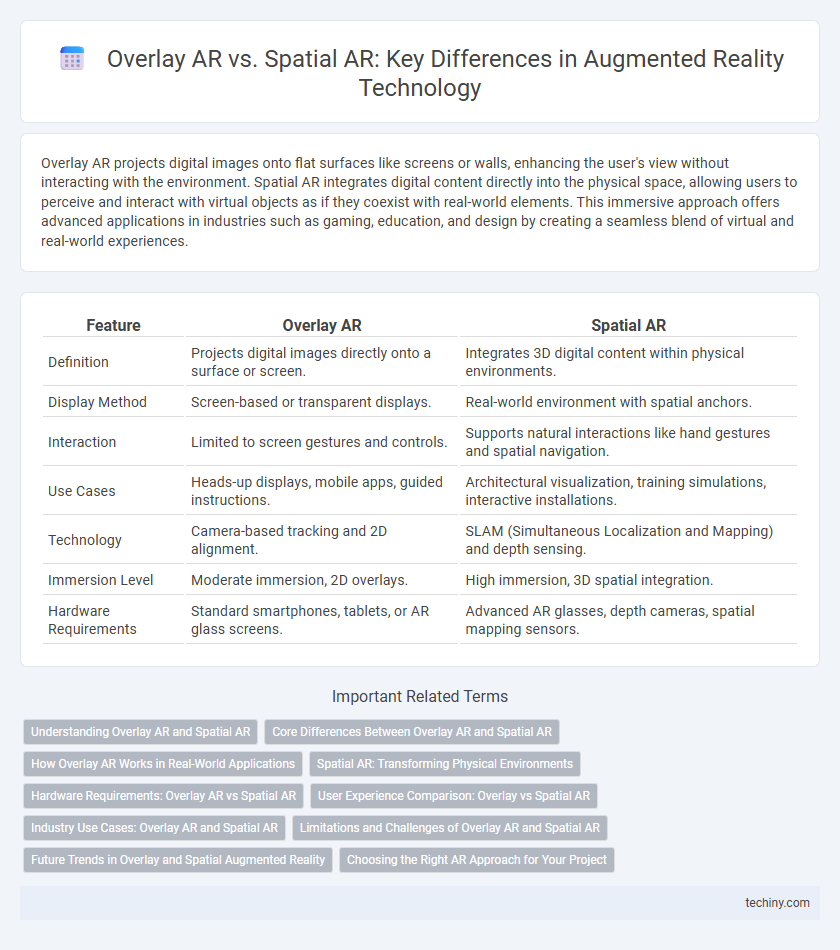Overlay AR projects digital images onto flat surfaces like screens or walls, enhancing the user's view without interacting with the environment. Spatial AR integrates digital content directly into the physical space, allowing users to perceive and interact with virtual objects as if they coexist with real-world elements. This immersive approach offers advanced applications in industries such as gaming, education, and design by creating a seamless blend of virtual and real-world experiences.
Table of Comparison
| Feature | Overlay AR | Spatial AR |
|---|---|---|
| Definition | Projects digital images directly onto a surface or screen. | Integrates 3D digital content within physical environments. |
| Display Method | Screen-based or transparent displays. | Real-world environment with spatial anchors. |
| Interaction | Limited to screen gestures and controls. | Supports natural interactions like hand gestures and spatial navigation. |
| Use Cases | Heads-up displays, mobile apps, guided instructions. | Architectural visualization, training simulations, interactive installations. |
| Technology | Camera-based tracking and 2D alignment. | SLAM (Simultaneous Localization and Mapping) and depth sensing. |
| Immersion Level | Moderate immersion, 2D overlays. | High immersion, 3D spatial integration. |
| Hardware Requirements | Standard smartphones, tablets, or AR glass screens. | Advanced AR glasses, depth cameras, spatial mapping sensors. |
Understanding Overlay AR and Spatial AR
Overlay AR projects digital content directly onto physical surfaces, enhancing the user's real-world view by adding images, text, or animations without considering the surrounding environment. Spatial AR, however, integrates virtual objects within a three-dimensional space, allowing interaction with the physical environment by mapping and understanding spatial relationships and depth. Understanding these distinctions is crucial for developing applications in gaming, education, and industrial design, where precise alignment and interaction with real-world elements are required.
Core Differences Between Overlay AR and Spatial AR
Overlay AR projects digital content onto a user's view without integrating it into the physical environment, often relying on 2D screens or simple heads-up displays. Spatial AR, however, anchors digital objects within the real world's 3D space, enabling interaction and alignment with physical surroundings through advanced tracking and mapping technologies. Key differences include spatial awareness, depth perception, and user immersion, with spatial AR providing a more seamless and interactive experience by merging virtual elements realistically within the environment.
How Overlay AR Works in Real-World Applications
Overlay AR works by superimposing digital content onto the user's view of the physical environment through devices like smartphones, tablets, or smart glasses, using cameras and sensors to track the surrounding space. It relies on image recognition and GPS data to place virtual objects accurately over real-world surfaces, enhancing experiences in sectors such as retail, gaming, and education. This technology enables users to interact with dynamic digital layers that appear seamlessly integrated with their immediate surroundings.
Spatial AR: Transforming Physical Environments
Spatial AR revolutionizes physical environments by projecting digital content directly onto real-world surfaces, eliminating the need for handheld devices or headsets. This technology enhances user interaction by seamlessly blending virtual elements with tangible surroundings, fostering immersive experiences in industries like architecture, manufacturing, and education. By leveraging depth sensing and advanced projection systems, spatial AR creates dynamic, context-aware environments that transform how users perceive and engage with their physical space.
Hardware Requirements: Overlay AR vs Spatial AR
Overlay AR primarily requires lightweight displays such as smartphones or tablets equipped with cameras and basic sensors for tracking, making it accessible with minimal hardware investment. Spatial AR demands more advanced hardware including depth sensors, spatial mapping cameras, and projectors to accurately integrate virtual content into the physical environment. The higher computational power and specialized devices inherent in spatial AR enable precise alignment and interaction within real-world spaces, distinguishing it from the simpler hardware needs of overlay AR.
User Experience Comparison: Overlay vs Spatial AR
Overlay AR projects digital content onto a flat surface or screen, limiting interaction to predefined areas and often causing occlusion issues that reduce immersion. Spatial AR integrates digital elements seamlessly into the physical environment, enabling intuitive interaction and natural navigation through 3D space, which significantly enhances user engagement and realism. The spatial AR experience fosters greater presence and usability, making it preferable for applications requiring depth perception and environmental context.
Industry Use Cases: Overlay AR and Spatial AR
Overlay AR enhances industrial workflows by projecting digital information directly onto physical objects, improving accuracy in assembly and maintenance tasks. Spatial AR leverages environmental mapping to integrate 3D holograms within workspace environments, facilitating complex design visualization and collaborative engineering. Industries such as manufacturing, automotive, and aerospace increasingly adopt overlay and spatial AR to reduce errors, accelerate training, and optimize production efficiency.
Limitations and Challenges of Overlay AR and Spatial AR
Overlay AR faces limitations such as reduced depth perception and occlusion issues, which affect the accurate alignment of digital content with real-world objects, leading to user immersion challenges. Spatial AR struggles with environmental variables like lighting and surface irregularities, impacting the stability and clarity of projections in dynamic settings. Both systems encounter challenges in scalability and real-time interaction, necessitating advancements in tracking accuracy and hardware performance for broader adoption.
Future Trends in Overlay and Spatial Augmented Reality
Future trends in overlay AR emphasize enhanced real-time data integration through AI-powered visual recognition and context-aware interfaces, enabling more precise and personalized user experiences. Spatial augmented reality is advancing with improved projection technologies and environmental mapping, allowing seamless blending of digital content onto physical surfaces without wearables. Continuous developments in edge computing and 5G connectivity further accelerate low-latency interaction, expanding applications in smart cities, industrial maintenance, and immersive entertainment.
Choosing the Right AR Approach for Your Project
Overlay AR projects virtual elements onto the user's view, ideal for simple, location-based applications requiring minimal environmental interaction. Spatial AR integrates digital content with the physical environment, offering immersive experiences through precise mapping and interaction within a three-dimensional space. Selecting the right AR approach depends on project goals, hardware capabilities, user engagement level, and the required depth of environmental integration.
overlay AR vs spatial AR Infographic

 techiny.com
techiny.com